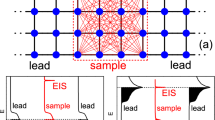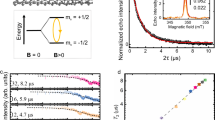Abstract
Single-wall carbon nanotubes1,2 are ideally suited for electron-transport experiments on single molecules because they have a very robust atomic and electronic structure and are sufficiently long to allow electrical connections to lithographically defined metallic electrodes. The electrical transport properties of single nanotubes3 and bundles of nanotubes4 have so far been interpreted by assuming that individual electrons within the nanotube do not interact, an approximation that is often well justified for artificial mesoscopic devices such as semiconductor quantum dots5. Here we present transport spectroscopy data on an individual carbon nanotube that cannot be explained by using independent-particle models and simple shell-filling schemes. For example, electrons entering the nanotube in a low magnetic field are observed to all have the same spin direction, indicating spin polarization of the nanotube. Furthermore, even when the number of electrons on the nanotube is fixed, we find that variation of an applied gate voltage can significantly change the electronic spectrum of the nanotube and can induce spin flips. The experimental observations point to significant electron–electron correlations. We explain our results phenomenologically using a model that assumes that the capacitance of the nanotube depends on its many-body quantum state.
This is a preview of subscription content, access via your institution
Access options
Subscribe to this journal
Receive 51 print issues and online access
$199.00 per year
only $3.90 per issue
Buy this article
- Purchase on Springer Link
- Instant access to full article PDF
Prices may be subject to local taxes which are calculated during checkout



Similar content being viewed by others
References
Bethune, D. S.et al. Cobalt-catalysed growth of carbon nanotubes with single-atomic-layer walls. Nature 363, 605–607 (1993).
Iijima, S. & Ishihashi, T. Single-shell carbon nanotubes of 1-nm diameter. Nature 363, 603–605 (1993).
Tans, S. J.et al. Individual single-wall carbon nanotubes as quantum wires. Nature 386, 474–477 (1997).
Bockrath, M.et al. Single-electron transport in ropes of carbon nanotubes. Science 275, 1922–1925 (1997).
Sohn, L. L., Kouwenhoven, L. P. & Schön, G. (eds) Mesoscopic Electron Transport(Kluwer Academic, Dordrecht, (1997)).
Thess, A.et al. Crystalline ropes of metallic carbon nanotubes. Science 273, 483–487 (1996).
Grabert, H. & Devoret, M. H. (eds) Single Charge Tunneling(Plenum, New York, (1992)).
Hallam, L. D., Weiss, J. & Maksym, P. A. Screening of the electron–electron interaction by gate electrodes in semiconductor quantum dots. Phys. Rev. B 53, 1452–1462 (1996).
Cobden, D. H.et al. Spin splitting and even–odd effects in carbon nanotubes. Phys. Rev. Lett. 81, 681–684 (1998).
Mintmire, J. W., Dunlap, B. I. & White, C. T. Are fullerene tubules metallic? Phys. Rev. Lett. 68, 631–634 (1992).
Hamada, N., Sawada, A. & Oshiyama, A. New one-dimensional conductors: graphitic microtubules. Phys. Rev. Lett. 68, 1579–1581 (1992).
Saito, R., Fujita, M., Dresselhaus, G. & Dresselhaus, M. S. Electronic structure of chiral graphene tubules. Appl. Phys. Lett. 60, 2204–2206 (1992).
Tarucha, S., Austing, D. G., Honda, T., van der Hage, R. J. & Kouwenhoven, L. P. Shell filling and spin effects in a few electron quantum dot. Phys. Rev. Lett. 77, 3613–3616 (1996).
Acknowledgements
We thank R. E. Smalley and co-workers for the supply of the indispensable single-walled carbon nanotubes. We also thank L. P. Kouwenhoven, T. H. Oosterkamp and Yu. V. Nazarov for discussions, and B. van den Enden for technical assistance. This work was supported by the Dutch Foundation for Fundamental Research on Matter (FOM).
Author information
Authors and Affiliations
Corresponding author
Rights and permissions
About this article
Cite this article
Tans, S., Devoret, M., Groeneveld, R. et al. Electron–electron correlations in carbon nanotubes. Nature 394, 761–764 (1998). https://doi.org/10.1038/29494
Received:
Accepted:
Issue Date:
DOI: https://doi.org/10.1038/29494
This article is cited by
-
Quantum Plasma Terahertz Oscillations Including Exchange Interactions of Electrons and Holes in Single-Walled Carbon Nanotubes
Journal of Low Temperature Physics (2022)
-
Recent progresses on the new condensed forms of single-walled carbon nanotubes and energy-harvesting devices
Chinese Science Bulletin (2012)
-
Electron liquids and solids in one dimension
Nature (2010)
-
Engineering atomic and molecular nanostructures at surfaces
Nature (2005)
Comments
By submitting a comment you agree to abide by our Terms and Community Guidelines. If you find something abusive or that does not comply with our terms or guidelines please flag it as inappropriate.



